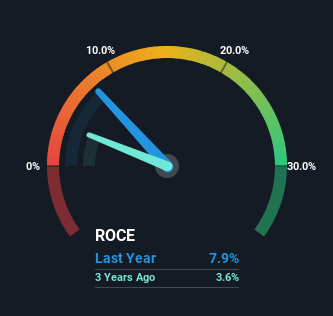- United States
- /
- Medical Equipment
- /
- NYSE:BSX
Boston Scientific (NYSE:BSX) Could Be Struggling To Allocate Capital

Did you know there are some financial metrics that can provide clues of a potential multi-bagger? Typically, we'll want to notice a trend of growing return on capital employed (ROCE) and alongside that, an expanding base of capital employed. Ultimately, this demonstrates that it's a business that is reinvesting profits at increasing rates of return. However, after briefly looking over the numbers, we don't think Boston Scientific (NYSE:BSX) has the makings of a multi-bagger going forward, but let's have a look at why that may be.
What Is Return On Capital Employed (ROCE)?
For those that aren't sure what ROCE is, it measures the amount of pre-tax profits a company can generate from the capital employed in its business. To calculate this metric for Boston Scientific, this is the formula:
Return on Capital Employed = Earnings Before Interest and Tax (EBIT) ÷ (Total Assets - Current Liabilities)
0.079 = US$2.3b ÷ (US$34b - US$4.6b) (Based on the trailing twelve months to September 2023).
Therefore, Boston Scientific has an ROCE of 7.9%. On its own, that's a low figure but it's around the 9.3% average generated by the Medical Equipment industry.
View our latest analysis for Boston Scientific

In the above chart we have measured Boston Scientific's prior ROCE against its prior performance, but the future is arguably more important. If you'd like to see what analysts are forecasting going forward, you should check out our free report for Boston Scientific.
The Trend Of ROCE
When we looked at the ROCE trend at Boston Scientific, we didn't gain much confidence. Around five years ago the returns on capital were 11%, but since then they've fallen to 7.9%. Meanwhile, the business is utilizing more capital but this hasn't moved the needle much in terms of sales in the past 12 months, so this could reflect longer term investments. It may take some time before the company starts to see any change in earnings from these investments.
On a side note, Boston Scientific has done well to pay down its current liabilities to 13% of total assets. So we could link some of this to the decrease in ROCE. Effectively this means their suppliers or short-term creditors are funding less of the business, which reduces some elements of risk. Since the business is basically funding more of its operations with it's own money, you could argue this has made the business less efficient at generating ROCE.
The Bottom Line
To conclude, we've found that Boston Scientific is reinvesting in the business, but returns have been falling. Since the stock has gained an impressive 63% over the last five years, investors must think there's better things to come. But if the trajectory of these underlying trends continue, we think the likelihood of it being a multi-bagger from here isn't high.
On a separate note, we've found 2 warning signs for Boston Scientific you'll probably want to know about.
If you want to search for solid companies with great earnings, check out this free list of companies with good balance sheets and impressive returns on equity.
Valuation is complex, but we're here to simplify it.
Discover if Boston Scientific might be undervalued or overvalued with our detailed analysis, featuring fair value estimates, potential risks, dividends, insider trades, and its financial condition.
Access Free AnalysisHave feedback on this article? Concerned about the content? Get in touch with us directly. Alternatively, email editorial-team (at) simplywallst.com.
This article by Simply Wall St is general in nature. We provide commentary based on historical data and analyst forecasts only using an unbiased methodology and our articles are not intended to be financial advice. It does not constitute a recommendation to buy or sell any stock, and does not take account of your objectives, or your financial situation. We aim to bring you long-term focused analysis driven by fundamental data. Note that our analysis may not factor in the latest price-sensitive company announcements or qualitative material. Simply Wall St has no position in any stocks mentioned.
About NYSE:BSX
Boston Scientific
Develops, manufactures, and markets medical devices for use in various interventional medical specialties worldwide.
Excellent balance sheet with reasonable growth potential.


